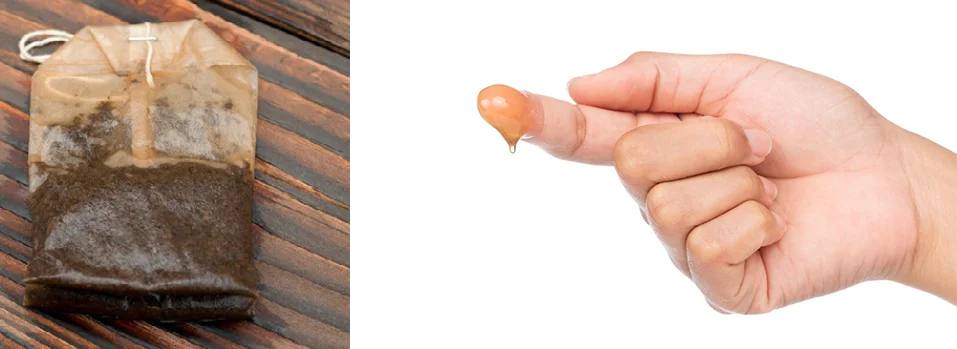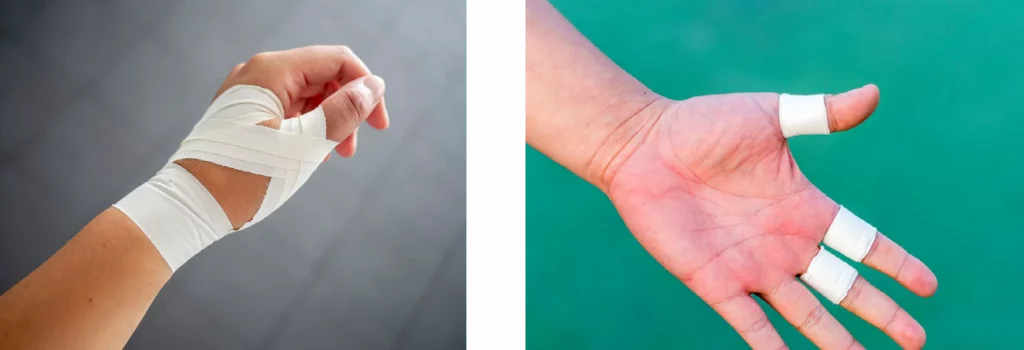What is a rip in gymnastics?
A gymnastics rip usually occurs when training more dynamic movements on rings or the bar but can also happen during handstand training on blocks, olympic weight lifting exercises or really when ever you grab anything and there is motion involved.
Rips are basically holes in the skin of your hand. They usually happen where too many calluses build up and are painful. If not properly taken care of they will slow your training process tremendously. As gymnasts naturally dislike all kinds of injuries we try to prevent rips as best as we can.
Why do gymnasts get rips?
During swings or movements with dynamic energy the upper layer of the skin can get separated from the blood rich lower layer due to friction. A blister is created which can sometimes fill with blood. A rip will usually quickly follow after. No matter your lever of training hand rips can happen to anyone.
The novice gymnast often grips too hard and does not allow the hands to properly slide on the bar creating too much friction. Poor form and technique will usually contribute to the ripping of the hands as well. The better you get the more precise you will be at adjusting your swings to keep impact soft and avoid already sore spots in your hands.
The pro who has been through lots of practice often rips the hands due to too much calluses on the hands or simply through overworking of the hands. Blister will happen on your journey towards higher level skills. Understanding when they are close and how to adjust training to avoid them is kew.
How do you prevent gymnastics rips?
You can almost always feel blisters coming and they must be avoided at all cost. Especially without proper care they can put you out of training for a while.
You will have to adjust your post training and night time rituals accordingly just like your technique and form might need to change to adjust your swing.
Take care of your hands
The best tip that I got as a young gymnast was to adopt a hand care routine. Wash your hands with soap and water after every training and apply lotion.
At night soak your hands in warm water for about 10 min to locate and soften the calluses. Rub them with a pumice stone. You want to remove some of the excess skin carefully. It will look and feel like dead skin. Don’t over do the rubbing with the pumice stone. You want to keep some calluses but control the amount. Otherwise your hands will hurt during your next training. Use fatty lotion and keep your hands well hydrated at all times.
Know your limits
Most blisters and rips happen simply because of overuse whilst training on bars. I know it is hard to stop when you are doing your thing at the gym but a couple attempts less today are always the better choice than not training at all for the next couple weeks. Watch your calluses carefully during your workout.
Train less but more focused and efficient. Make every set count!
Use protection

Gymnasts use grips for a reason. Whilst they take some time to get used to they do not only offer big amounts of support and higher slip protection but they also protect the skin from rubbing and ripping.
Applying chalk can also often help. Chalk will give you a better grip and even prevent your hands from sliding. More control means you can squeeze less hard with your hands and during your workouts and your hands are less likely to rip.
Last but not least we have gloves. Depending on what sport exactly you are practicing lifting gloves can be a more than valid solution. If you are working strength based drills they can offer similar or even better support than regular gymnastics grips.
How do you treat a gymnastics rip?
Once the rip is here you are most likely going to suffer a fair bit unless you apply proper post injury hand care. I’ve managed to get through rips with hardly any pain or missed gym workouts simply by applying cream when ever the rip starts to dry up. All you have to do is treat your blisters right to build new skin.
How long do gymnastics rips take to heal?
While this depends on the gymnast, the severity of the rip and how well you treat the skin post injury a rip can usually do the most essential healing within 3-5 days.
How do you heal ripped hands fast?
Most importantly handle your rip with care and respect. This is an open wound. Use a sterilized tools to avoid infection and remove excess skin carefully. Wash your hands with warm water and non perfumed soap.
Cover the whole with an over the counter available antibiotic ointment. Your injury should be able to breath. Definitely reapply the cream right before bed and cover the crack lightly so your ointment doesn’t go on sheets or in your face. The goal is that there is no cracking due to dryness in the morning. You can even consider attaching a spoon or chop sticks to the back of your hand to force it open while you sleep. Like this it will heal in a stretch position and won’t rip in the morning.
Repeat this until a new layer of skin has been created.
The key to build new skin really is to keep the wound well most. Constantly apply Vaseline or your antibiotic ointment. If the rip gets dry it will crack. This will cause discomfort and more and deeper rips.
Treat your cuts with Vitamin E & Tea Bags

The tannic acid from tea protects the skin from inflammation caused by external irritation. It will help with the pain and promotes skin growth through the inhibition of the formation and removal of reactive oxygen substances. Simply make a cup of tea, let the teabag cool down and apply it straight to your cut.
Vitamin E has been considered an anti-inflammatory agent in the skin and vitamin E rich oil is absorbed quickly as it is fat-soluble and it is said to controls the production of collagen and elastin in the skin. Whilst collagen strengthens the skin it may also help with its elasticity and hydration.
Neosporin is an ointment that combines Vitamin E and 3 antibiotics. It can help with your recovery quite a bit but should be used with care as some including me react allergic to it. Stop using it right away if your skin becomes red and itchy. If allergic the longer you use the ointment the worst the reaction will get.
How to train with a gymnastics rip?
We can try to precent rips as much as we want but the worst is usually unavoidable. Once your hand is ripped training should be adjusted for the first day or 2. It is important for any gymnast to learn how to train with a ripped hand as you never know how close to a competition the next rip will occur.
How to tape your gymnastics blister
When you train cover the blister of your hand with tape. You might have to ask your coach or fellow gymnast to help you. Placement of the tape is quite important and you might need some practice with it. Never put the sticky side of the tape on rip. Best is to build a small foam cut out to always keep distance between the rip and any kind of bandage. If you have no foam available simply turn 1 bandage upside down to cover the crack and use regular tape to attache it around the back of the hand.
Make sure to wash your hands extra carefully with soap and water and apply your cream to keep the skin from drying out and cracking.

Dealing with the pain of gymnastics rips
Icing your hands and blisters after training is possibly the best way to help with pain management. Additionally, it will stimulate blood flow to help and speed up the healing process.
Blisters, cracks and rips are no fun and must be prevented at all costs. Once the hand is open proper care is vital and can reduce discomfort and recovery time immensely.
Use the tips provided in this article for prevention and healing of cracking and ripping of the hands during gymnastics training. Make sure to always have good lotion in your bag to keep your hands moisturized.






